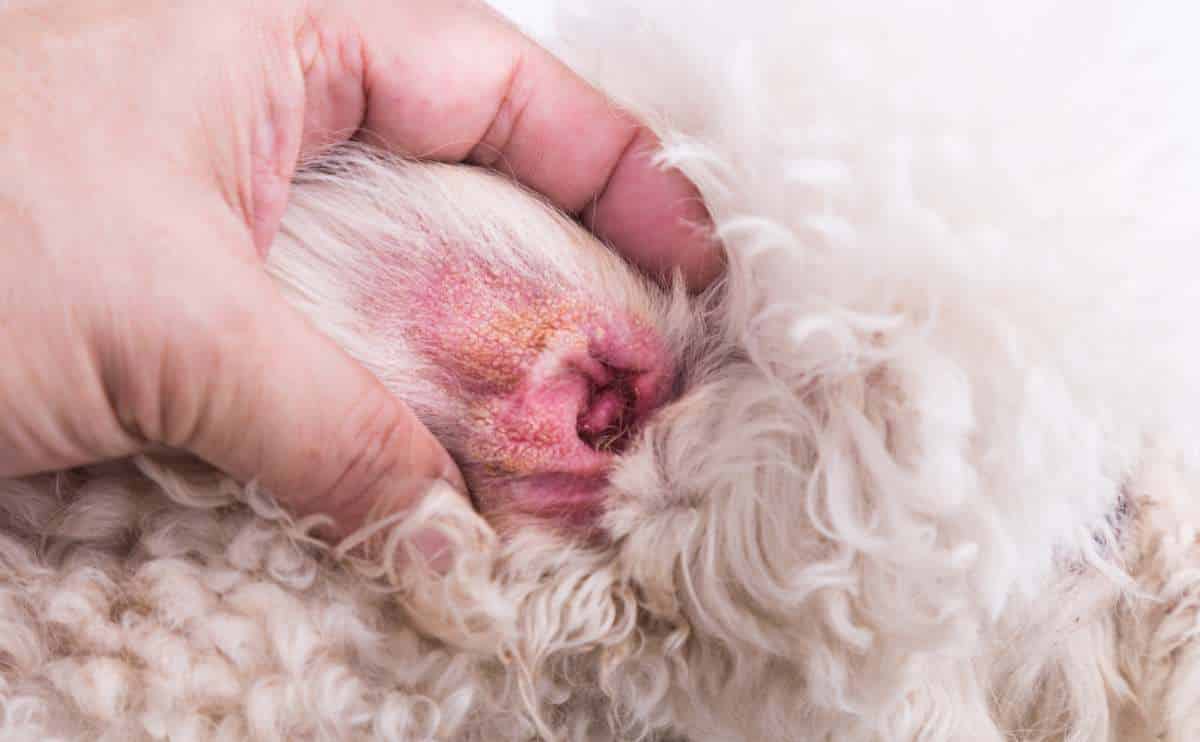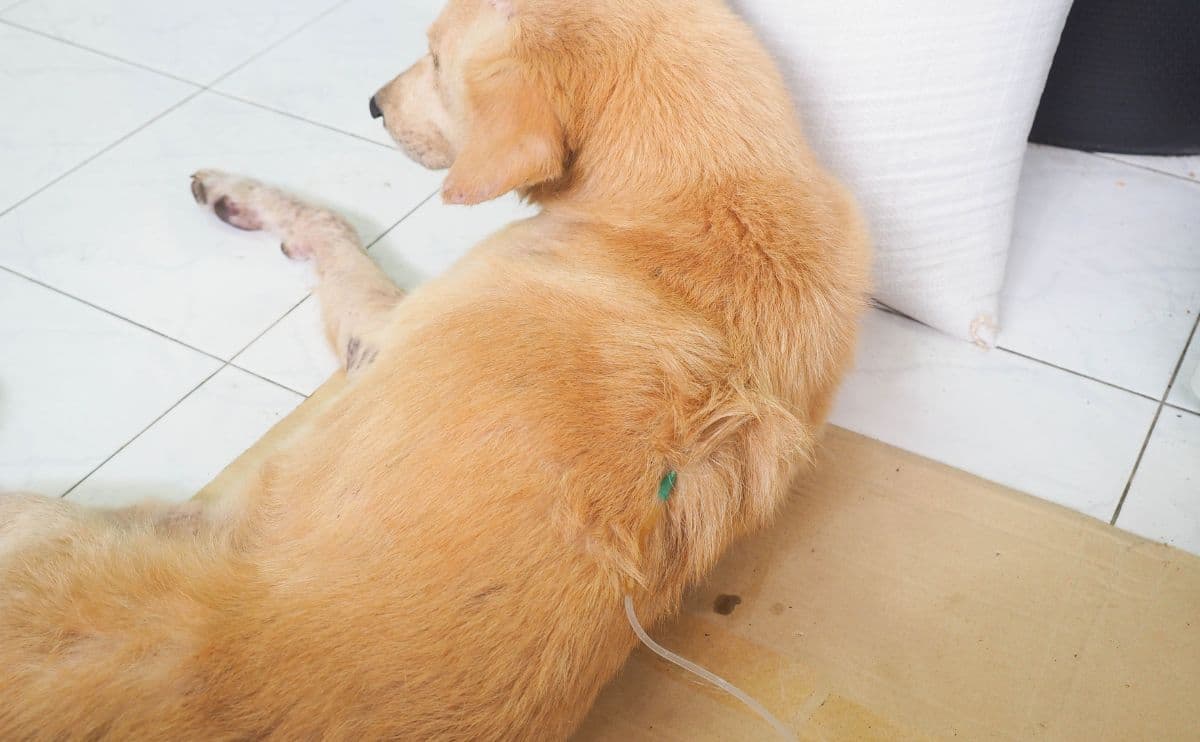When you purchase through links on our site, we may earn a commission. Here’s how it works.

Is your dog shaking his head a lot or scratching his ears? Have you noticed that his ears are swollen? If so, your dog could be suffering from an ear hematoma. I’ll help you recognize the signs, know when to seek treatment, and what you can do to help prevent this condition from reoccurring.
What Is A Dog Ear Hematoma?
Ear or aural hematomas are firm, swollen blisters on the inside of your dog’s ear flap. They occur when blood vessels within the ear flap burst, and bleeding occurs in the space between the ear cartilage and the skin.
Causes
Hematomas can form due to trauma caused by excessive head shaking or scratching. Often, the underlying cause is itching and pain from ear mites, allergies, or an ear infection. They can also form when a foreign object is lodged inside your dog’s ear or as a result of a bite wound.
Dogs with long, floppy ears, like Beagles and Dachshunds, have a higher risk of developing ear hematomas. Dogs with clotting or bleeding disorders may also develop hematomas more easily, even without the trauma of shaking or scratching.
What The Veterinarian Says About Dog Ear Hematomas
I asked Dr. Hannah Godfrey, BVetMed MRCVS, about aural hematomas in dogs and what owners should know. Here’s what she shared:
“Ear hematomas are uncomfortable and irritating for dogs but shouldn’t be drained or treated by you at home. Going near your dog’s ear with any sharp object is best done at the vet, where the trained team can restrain them, use sedation if needed, and ensure treatment is quick and safe. It can also make a huge mess, and there’s a risk of infection if not drained and treated effectively. However, there are a few methods that your vet might use to drain the hematoma, and one involves placing a little tube that allows any build-up of blood or fluid to drain constantly at home.”
Dr. Godfrey continues, “Sadly, while your dog’s ear will eventually scar and become misshapen and thickened – like a human’s ‘cauliflower ear’ from rugby or combat sports – the underlying cause is likely to be an ear infection or allergies, which won’t just go away on their own.“
Dr. Godfrey cautions, “Although not an emergency, ear infections and hematomas can cause pain, so it’s best to seek veterinary care as soon as possible. I’ve treated many ear hematomas over the years, and it can be frustrating if they take a long time to settle or need draining a few times. I used to place a temporary drain quite frequently or occasionally perform surgery. However, I’ve found that getting the ear infection under control and managing the inflammation with medication for a few days means that the first drainage is usually successful.”
Ear Hematoma Symptoms
Dog ear hematomas are fairly easy to spot. Signs to look for include:
- Swelling on the ear flaps
- Discoloration
- Deformity in the ear shape
- Pain and aversion to touch
- Scratching or head-shaking
Hematoma Diagnosis
Hematomas can cause your dog discomfort, so he’ll likely shake his head and scratch even more. This can exacerbate the problem and cause even more blisters to form. That’s why getting a diagnosis and proper treatment is important.
If you suspect that your dog has an ear hematoma, consult with your vet. Your vet will perform a physical examination and a simple needle extraction of the blister — the presence of blood confirms an ear hematoma.
Seeking veterinarian care is also important because your dog could be suffering from ear mites or an infection that’s causing the head shaking and scratching.
Treatment
Dog ear hematomas aren’t life-threatening, but you should seek treatment as soon as possible. Without treatment, the hematoma may eventually heal on its own, but it will likely scar and cause a permanent ear disfigurement, which is referred to as cauliflower ear. Cauliflower ear can lead to obstruction of the ear canal. Inflammation can spread and damage other ear tissues.
There are several ways to treat a dog’s ear hematoma, and your vet will choose the best method on a case-by-case basis.
Draining
Draining is often the preferred course of treatment for small hematomas. This can be done with a needle, which is called a needle aspiration. Your vet can do this in the office and may inject steroids or antibiotics into the ear after draining. For some smaller hematomas, some vets may opt to make a small incision in your dog’s ear flap and insert a tube to help the blister drain. Some vets prefer to use a drainage tube called a teat cannula, a tube used to treat mastitis in cows.
This method involves diligent follow-up care. You’ll have to gently massage your dog’s ear to keep the fluid draining over several days and then return to your vet to remove the tube and close the incision.
The downside of solely using a draining tube is that it doesn’t do a good job of compressing the cartilage and skin back together. So, there’s a greater risk of disfigurement, especially with larger hematomas. That’s why many vets prefer surgery.
Our Personal Experience Treating Dog Ear Hematoma
My Goldendoodle, Gary, developed an ear hematoma due to excessive head shaking when he had an ear infection. While it was quite scary looking, my vet was able to easily drain the hematoma, and luckily, it didn’t return. The total cost for the procedure was less than $100.
– Jeff Butler, Goldendoodle Owner, Canine Journal Analytics & SEO
Surgery
one of the main questions I’ve come across is, “Do dogs need surgery for ear hematomas?” This can only truly be answered on a case-by-case basis, but surgery is usually the best option to reduce the risk of disfigurement and prevent recurrence. However, surgery requires your dog to undergo anesthesia and post-operative recovery.
Specific surgical techniques vary according to the vet’s preference and your dog’s unique circumstances, but they typically involve the same basic steps.
- The skin over the hematoma will be surgically incised to drain the blood and remove any blood clots.
- Numerous stitches (sutures) will be placed through the ear to reattach the cartilage to the skin and eliminate scar tissue formation. This helps prevent the recurrence of hematomas.
- A surgical drain may be placed to promote drainage.
- The pinna, or ear flap, will be bandaged to minimize damage and promote healing.
- Your vet may recommend a no-flap ear wrap, like the Happy Hoodie, to keep your dog’s ears secure while he heals.
Your vet will remove drainage tubes or bandages after 3-14 days, and the stitches may be removed after 2 weeks if the ear is completely healed. If not healed, some or all of the sutures may need to remain for an additional 2 weeks.
What Does Dog Ear Hematoma Surgery Cost?
You might be wondering, how much does dog ear hematoma surgery cost? The cost can run anywhere from $250-$500 or more, depending on the size of the hematoma and the extent of follow-up care by your vet. Having pet insurance can be a smart way to avoid unexpected treatment costs, like dog ear hematoma surgery or even more serious conditions that could arise at any time. See our guide on the best pet insurance to learn more.
Frequently Asked Questions
Below, I’ve answered a few of the most frequently asked questions about dog ear hematomas. Let me know in the comments if I missed yours.
Should I Drain My Dog’s Ear Hematoma?
While you can find some instructional videos online on how to drain your dog’s ear hematoma at home with a syringe, we don’t recommend it. Using a syringe to drain the fluid rarely solves the problem because the fluid returns repeatedly. And you run the risk of injuring your dog.
Can A Dog Ear Hematoma Heal On Its Own?
Left untreated, a hematoma will slowly reabsorb into the body. However, it is quite painful and will cause permanent damage, and the underlying cause will not be treated either. It may also lead to additional issues, including a blockage of the ear canal. Without treatment, the hematoma may never fully heal.
Are There Natural Alternative Treatments?
Some holistic veterinarians find moderate success using homeopathic remedies, like arnica oil or colloidal silver, to treat very small ear hematomas. But often, this isn’t a long-term solution because the hematoma starts to clot and harden, making homeopathy less effective.
Does My Dog Have An Ear Infection?
Your dog could have an underlying ear infection that’s led to a hematoma, and it’s important to find out in order to get appropriate treatment. Read our guide on dog ear infections to get tips about how to spot, treat, and prevent this common condition. We also cover common antibiotics used to treat dog ear infections. Preventing ear infections is one of the best ways to prevent hematomas from forming. While we’re on the subject, you may want to check out our tips on how to clean your dog’s ears.
Why Trust Canine Journal?
Sally has over 20 years of experience in human health sciences communications, including 10 years as an expert on pet health conditions and treatment. She’s part of a team of dedicated canine professionals and long-time dog owners at Canine Journal. We test and research the best pet products, not only for our own pups but for all of our readers.
Tagged With: Ears

